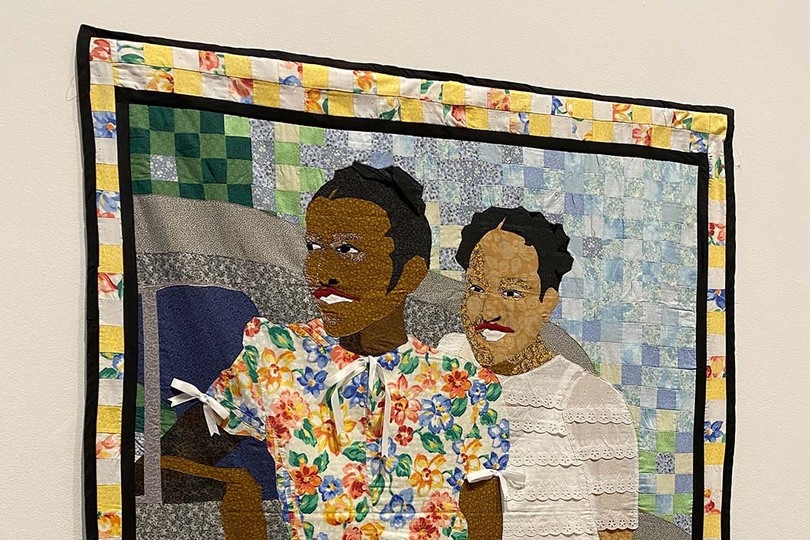Dawn Williams Boyd’s exhibit ‘Woe’ crafts fiber art into timeless historical portrayals

Anthony Bailey | Asst. Culture Digital Editor
Boyd often visits places like Goodwill and yard sales to find inspiration and materials to use for her work.
Get the latest Syracuse news delivered right to your inbox.
Subscribe to our newsletter here.
Dawn Williams Boyd loves to collect things.
“I’m trying to find a polite way to put it,” Boyd said, laughing. “My husband and I … like to collect other people’s stuff.”
This includes going to Goodwill, Habitat for Humanity, used bookstores and yard sales and combing through the leftovers of previous generations. At one yard sale, Boyd came across a little black book. The book was about Harry Tyson Moore, an early leader in the civil rights movement, and it contained pictures of Moore and his family.
One of those pictures was of his two daughters, Annie “Peaches” Rosalea and Juanita Evangeline, Boyd said. The photograph, like others from 1942, was shot in black and white. Boyd saw the photo as an opportunity to both create a work that featured 1940s fashion and have the freedom to be creative with the colors and fabrics used in the clothing of the two girls.
What followed was Boyd’s 2004 work “Peaches and Evangeline: Bibbs County, FL 1942,” a cloth painting made by layering multiple fabrics on each other and also painting over those fabrics, the same medium as many of the works displayed in the Everson Museum of Art’s exhibition of Boyd’s works, “Woe.”
Boyd’s use of cloth came from a family tradition of seamstresses, as her grandmother, mother and aunt are all seamstresses, and she had been working with cloth her whole life. After working with more traditional mediums at the start of her art career, she said the transition to cloth paintings was straightforward.
“Since I was drawing as a preliminary for my painting anyway, the only thing that really changed was I changed out acrylic paints for fabric, and I changed out a brush to apply it with, to a palette knife to apply it,” Boyd said. “It was just a different way to think about it.”
“Peaches and Evangeline” was originally made to be a part of Boyd’s series “The Sins of Our Fathers,” a series about racial injustice and violence against Black Americans in the U.S. Boyd added the artwork because of the important civil rights activism of Harry T. Moore along with of the violence of his death — a bomb was placed under his bed, killing Moore and leading to the death of his wife, Harriette.
Originally curated by Daniel Fuller for the Lamar Dodd School of Art at the University of Georgia, the exhibition contains pieces of her work, including an abstract depiction of slave trading in “The Middle Passage” to a portrait in “Abebe, Chinwe’s Daughter.” The theme of critiquing social injustices in the U.S. is the motif of Boyd’s exhibit, he said.
Fiber art, in general, is kind of a hot topic now. It’s definitely grown in popularity in recent years.Steffi Chappell, assistant curator at the Everson Museum
Steffi Chappell, the assistant curator at the Everson Museum, said that having Boyd’s work on display is important because of the level of Boyd’s work as well as the growth of interest in fiber art in the art community.
“(Boyd) is absolutely the caliber of an artist that deserves a solo museum show,” Chappell said. “Fiber art, in general, is kind of a hot topic now. It’s definitely grown in popularity in recent years.”
In “The Middle Passage,” Boyd said she dabbled with the form and material of her subjects, as the central figures, two Black men on a boat, are two whole pieces of cloth. Next to them is half of a skeleton, whose ribs are made out of silk, standing in front of an abstracted ocean that was made to be juxtaposed to the brown of the boat.
Boyd said this experimentation with form and material fits with her process of creation. In order to keep herself and her audiences interested, she said she tries to experiment and innovate to stay one step ahead of others working in fabrics.
Fuller said he hopes that “Woe,” which will be on display at the Everson until April 10, will lead viewers to look closely at Boyd’s works and dive into them.
“I encourage people to, figuratively, not literally, pull the thread of the work,” Fuller said. “She had a story to tell for a long time and now she’s getting a chance to put that out to a wider audience.”
The story Boyd is telling, however, may be hard to hear, Fuller said. She said she hopes to tell an unaltered history that speaks the honest truth about what has happened in the past, especially in the history of violence and injustice against Black Americans.
Boyd hopes that viewers of her work will look more into the history of the music and art surrounding them, she said, and she believes that looking to the past for counsel is the only way to ensure certain mistakes and atrocities are never committed again.
“We have seen in the last five or ten years Black Americans being murdered on YouTube,” Boyd said. “That’s not any different from what’s been happening for the last four or five hundred years. We just didn’t have YouTube. That’s the only difference.”





